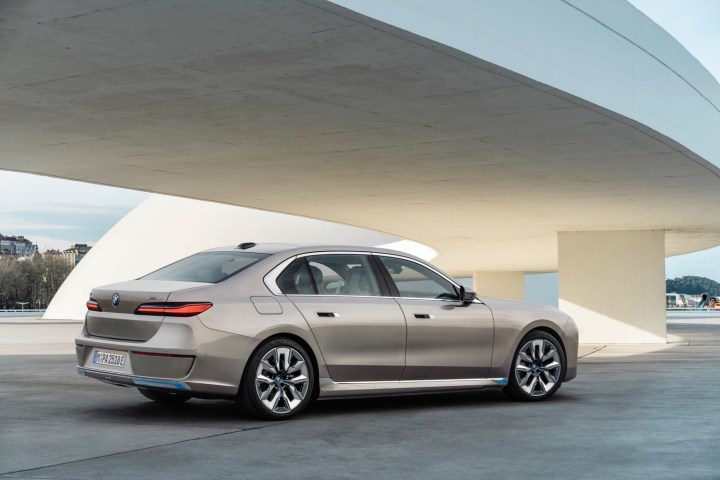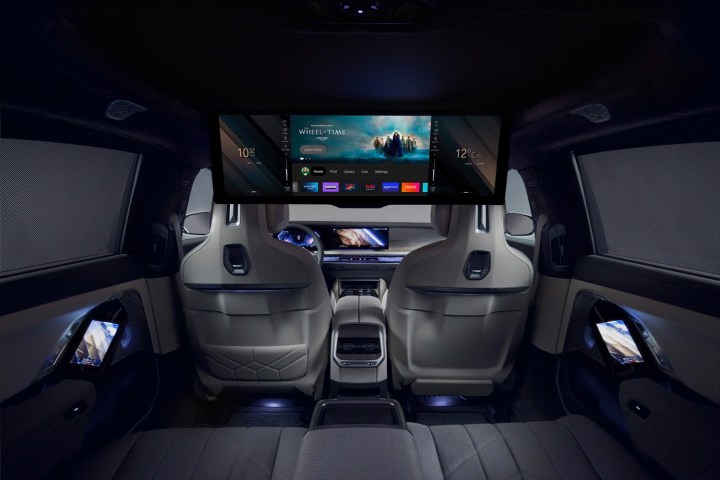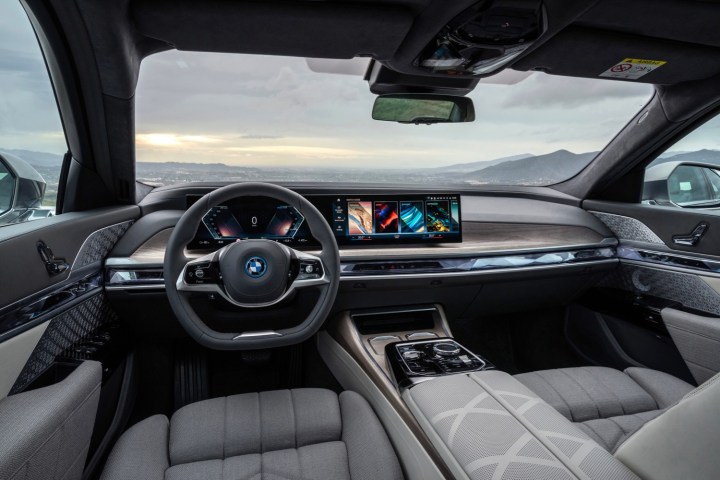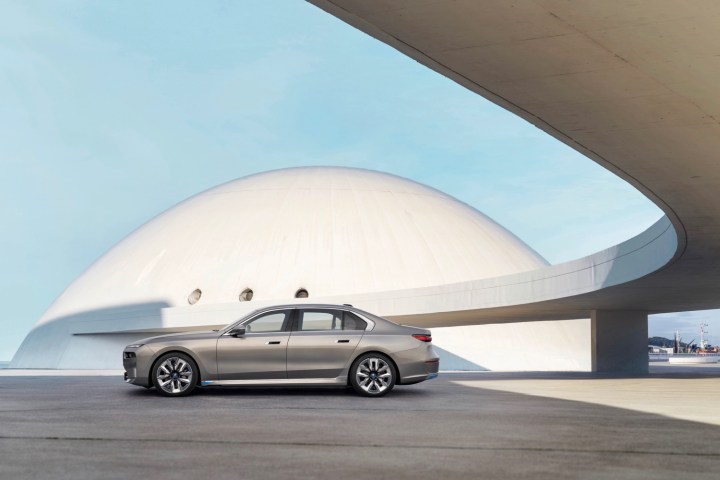BMW is no stranger to electric vehicles. It launched the quirky i3 hatchback in 2014, and followed it up more recently with the i4 and iX. But now BMW is making its flagship vehicle electric.
The BMW 7 Series is the automaker’s biggest, most opulent sedan, and for the 2023 model year, it gets a redesign that includes a first-ever electric variant. The 2023 BMW i7 xDrive60 (to use its full name) will start shipping to U.S. dealerships in November alongside gasoline 7 Series models (a hybrid version will arrive later as well).
While all 7 Series models get dramatic new styling , an elaborate infotainment system, and optional rear-seat entertainment system, BMW’s decision to launch an electric version of a gasoline model puts it out of step with other makers of high-end sedans. Mercedes-Benz chose to design its EQS sedan from the ground up rather than make an electric S-Class. The i7 will be priced close to the Lucid Air and Tesla Model S,
BMW has its own family of purpose-built EVs on the way. Dubbed Neue Klasse (German for “New Class”) in reference to a family of models that saved the company in the 1960s, they won’t arrive until 2025. So is the i7 just a placeholder, or a worthy EV in its own right?
Design
The i7 shares exterior styling with the gasoline 7 Series, marking a dramatic departure from previous 7 Series models. In keeping with recent BMW design practices, the i7 gets a massive grille that looks like a butterflied steak, with available illumination.
BMW is also switching things up with stacked lighting elements that place the daytime running lights above the headlights, not unlike the arrangement you get on a Hyundai Kona. European models get matrix LED tech that can automatically redirect high beams away from oncoming cars, but this won’t be available in the U.S. pending implementation of new regulations.
Walking around the i7 during a media preview, the thing that stood out was the car’s gargantuan size. It’s still a sedan with a fairly low seating position, but it has considerable visual girth nonetheless. The hood is so tall that it actually sits above the grille, and the trunk lid has what looks like a double chin to hide its height. The car we saw had 20-inch wheels, but they looked tiny positioned within the massive expanse of sheet metal.
Like the exterior, the interior is a major change from previous iterations of the 7 Series. In place of the outgoing model’s conservative design is a shelf-like dashboard shaped to house the new freestanding BMW Curved Display screen, elaborate speaker grilles, and ambient lighting to match the rival Mercedes S-Class. Dashboard trim, seat controls, infotainment system controller, and the shifter are also rendered in a crystal material that wouldn’t look out of place on the set of the original Star Trek series.
Tech
The i7’s signature piece of tech isn’t for the driver. It’s the optional Theater Screen, a 31.3-inch 8K display that folds down from the headliner, letting rear-seat passengers stream movies and television shows or play video games at speed. Videos are displayed in 16:9, 21:9, or 32:9 cinemascope aspect ratios.
Amazon Fire TV and a Bowers & Wilkins Diamond surround sound system are included as well, along with smartphone-like controllers in the rear doors. Netflix integration will allow users to start a movie at home and finish it in the car, Pieter Nota, BMW North America board member for customer affairs, said at the i7 media preview. However, the Theater Screen will likely limit rear visibility and, with an expected $4,750 price tag, it won’t be cheap.
Up front, the aforementioned BMW Curved Display consists of a 12.3-inch instrument cluster and 14.9-inch touchscreen under one piece of glass. BMW’s iDrive infotainment system returns with its familiar rotary controller, but also gains a new Interaction Bar with touchpads for climate control and other functions. The i7 also gets 5G connectivity and over-the-air (OTA) update capability.
BMW also collaborated with Academy Award-winning composer Hans Zimmer on distinctive sounds activated when the driver starts the car, or when switching between different drive modes.
The i7 gets a long list of available driver aids. The headline feature is Highway Assistant, which provides what BMW calls hands-free driving at speeds up to 80 mph, although it still requires drivers to pay attention and be ready to grab the steering wheel is needed. Other features include forward-collision warning, lane-departure warning, speed-limit assist, and an automated parking feature.
Specifications
The i7 launches with a dual-motor all-wheel drive powertrain producing 536 horsepower and 549 pound-feet of torque. BMW says it will do zero to 60 mph in 4.5 seconds, and the top speed is electronically limited to 149 mph.
Those specs are pretty close to the 760i xDrive, the more powerful of the two gasoline 7 Series models that will be available at launch. This model’s 4.4-liter twin-turbocharged V8 produces identical horsepower to the i7, but with 553 lb-ft of torque. BMW also quotes a slightly quicker 4.2-second zero-to-60 mph time.
BMW isn’t stopping there, though. At a media roundtable, chairman Oliver Zipse confirmed that the automaker will also launch an M Performance version of the i7, adding that it will be the most powerful 7 Series model.
BMW is also targeting 300 miles of range for the i7. The big sedan will be able to charge at up to 11 kilowatts using an AC charger and 195 kilowatts using DC fast charging, with the latter adding 80 miles of range in 10 minutes. Owners will also get three years of free DC fast charging from Electrify America.
Pricing and rivals
“We don’t want customers to make any compromises going from one vehicle to another,” Zipse told Digital Trends regarding the rationale for making an electric version of a gasoline car rather than a clean-sheet EV. “They get a 7 Series either way.”
The 2023 7 Series may be well positioned against traditional rivals like the Mercedes S-Class, Audi A8, and Lexus LS, but the i7 might not stack up as well against the electric competition.
A 300-mile range is adequate, but that puts the i7 far behind the 516-mile Lucid Air, 405-mile Tesla Model S, and 350-mile Mercedes EQS. It’s also unclear if EV buyers will want a car that looks like an old-fashioned gas guzzler, complete with an elongated hood designed to accommodate a V8 engine.
By making the i7 so similar to the gasoline 7 Series, BMW may have also stacked the deck against it. Until that M Performance version arrives, the i7 can only match its sibling in performance while demanding a price premium. Pricing for the i7 xDrive60 model starts at $120,295, compared to $114,595 for the gasoline 760i xDrive. BMW is also building a less-powerful six-cylinder 740i model starting at $94,295.
So it’s possible that many customers will choose the cheaper gasoline models, which also don’t come with the headaches of charging. The 7 Series is an impressive car, but the i7 doesn’t seem ready to attract new EV buyers.
Editors’ Recommendations








